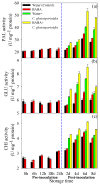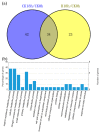β-Aminobutyric Acid Priming Acquisition and Defense Response of Mango Fruit to Colletotrichum gloeosporioides Infection Based on Quantitative Proteomics
- PMID: 31487826
- PMCID: PMC6770319
- DOI: 10.3390/cells8091029
β-Aminobutyric Acid Priming Acquisition and Defense Response of Mango Fruit to Colletotrichum gloeosporioides Infection Based on Quantitative Proteomics
Abstract
β-aminobutyric acid (BABA) is a new environmentally friendly agent to induce disease resistance by priming of defense in plants. However, molecular mechanisms underlying BABA-induced priming defense are not fully understood. Here, comprehensive analysis of priming mechanism of BABA-induced resistance was investigated based on mango-Colletotrichum gloeosporioides interaction system using iTRAQ-based proteome approach. Results showed that BABA treatments effectively inhibited the expansion of anthracnose caused by C. gleosporioides in mango fruit. Proteomic results revealed that stronger response to pathogen in BABA-primed mango fruit after C. gleosporioides inoculation might be attributed to differentially accumulated proteins involved in secondary metabolism, defense signaling and response, transcriptional regulation, protein post-translational modification, etc. Additionally, we testified the involvement of non-specific lipid-transfer protein (nsLTP) in the priming acquisition at early priming stage and memory in BABA-primed mango fruit. Meanwhile, spring effect was found in the primed mango fruit, indicated by inhibition of defense-related proteins at priming phase but stronger activation of defense response when exposure to pathogen compared with non-primed fruit. As an energy-saving strategy, BABA-induced priming might also alter sugar metabolism to provide more backbone for secondary metabolites biosynthesis. In sum, this study provided new clues to elucidate the mechanism of BABA-induced priming defense in harvested fruit.
Keywords: anthracnose; fruit; priming; proteome; stress; β-aminobutyric acid.
Conflict of interest statement
The authors declare no conflict of interest.
Figures








Similar articles
-
Transcriptome characterization and expression profiles of the related defense genes in postharvest mango fruit against Colletotrichum gloeosporioides.Gene. 2016 Jan 15;576(1 Pt 2):275-83. doi: 10.1016/j.gene.2015.10.041. Epub 2015 Oct 20. Gene. 2016. PMID: 26496007
-
Melatonin induces resistance against Colletotrichum gloeosporioides in mango fruit via regulation of defense-related genes by MiWRKY45 transcription factor.Int J Biol Macromol. 2025 Jan;287:138606. doi: 10.1016/j.ijbiomac.2024.138606. Epub 2024 Dec 9. Int J Biol Macromol. 2025. PMID: 39662543
-
Proteomic analysis of elicitation of downy mildew disease resistance in pearl millet by seed priming with β-aminobutyric acid and Pseudomonas fluorescens.J Proteomics. 2015 Apr 29;120:58-74. doi: 10.1016/j.jprot.2015.02.013. Epub 2015 Mar 3. J Proteomics. 2015. PMID: 25746381
-
Advances in Physiological, Transcriptomic, Proteomic, Metabolomic, and Molecular Genetic Approaches for Enhancing Mango Fruit Quality.J Agric Food Chem. 2023 Jan 11;71(1):20-34. doi: 10.1021/acs.jafc.2c05958. Epub 2022 Dec 27. J Agric Food Chem. 2023. PMID: 36573879 Review.
-
Nanotechnology for controlling mango malformation: a promising approach.J Biomol Struct Dyn. 2025 Mar;43(5):2610-2630. doi: 10.1080/07391102.2024.2312449. Epub 2024 Feb 12. J Biomol Struct Dyn. 2025. PMID: 38344816 Review.
Cited by
-
Emerging Trends in Non-Protein Amino Acids as Potential Priming Agents: Implications for Stress Management Strategies and Unveiling Their Regulatory Functions.Int J Mol Sci. 2024 Jun 4;25(11):6203. doi: 10.3390/ijms25116203. Int J Mol Sci. 2024. PMID: 38892391 Free PMC article. Review.
-
Protein Kinase Signaling Pathways in Plant-Colletotrichum Interaction.Front Plant Sci. 2022 Jan 20;12:829645. doi: 10.3389/fpls.2021.829645. eCollection 2021. Front Plant Sci. 2022. PMID: 35126439 Free PMC article. Review.
-
Combination of β-Aminobutyric Acid and Ca2+ Alleviates Chilling Stress in Tobacco (Nicotiana tabacum L.).Front Plant Sci. 2020 May 13;11:556. doi: 10.3389/fpls.2020.00556. eCollection 2020. Front Plant Sci. 2020. PMID: 32477386 Free PMC article.
-
Oxathiapiprolin, a Novel Chemical Inducer Activates the Plant Disease Resistance.Int J Mol Sci. 2020 Feb 12;21(4):1223. doi: 10.3390/ijms21041223. Int J Mol Sci. 2020. PMID: 32059380 Free PMC article.
-
Elicitor Specific Mechanisms of Defence Priming in Oak Seedlings Against Powdery Mildew.Plant Cell Environ. 2025 Jun;48(6):4455-4474. doi: 10.1111/pce.15419. Epub 2025 Feb 25. Plant Cell Environ. 2025. PMID: 40001308 Free PMC article.
References
Publication types
MeSH terms
Substances
LinkOut - more resources
Full Text Sources
Research Materials

